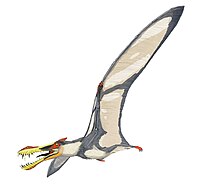Liaoningopterus
|
Liaoningopterus Temporal range: Early Cretaceous, 120 Ma |
|
|---|---|
 |
|
| Scientific classification | |
| Kingdom: | Animalia |
| Phylum: | Chordata |
| Class: | Reptilia |
| Order: | †Pterosauria |
| Suborder: | †Pterodactyloidea |
| Family: | †Anhangueridae |
| Genus: |
†Liaoningopterus Wang & Zhou, 2003 |
| Type species | |
|
†Liaoningopterus gui Wang & Zhou, 2003 |
|
Liaoningopterus, sometimes misspelled "Liaoningopteryx", was a genus of ornithocheirid pterodactyloid pterosaur from the Barremian-Aptian-age Lower Cretaceous Jiufotang Formation of Chaoyang, Liaoning, China.
The genus was named in 2003 by Wang Xiaolin and Zhou Zhimin. The type species is Liaoningopterus gui. The genus name is derived from Liaoning and a Latinised Greek pteron, "wing". The specific name honours Professor Gu Zhiwei, an invertebrate specialist who has pioneered the study of the Jehol Biota.
The genus is based on holotype IVPP V-13291, a crushed partial skull and skeleton including the jaws, teeth, a cervical vertebra, and bones of the finger supporting the wing. It was a large pterosaur — the largest known from China at the time of description — with a skull length estimated at 61 cm (24 in), and a wingspan estimated at five metres (16.4 ft). The skull was long and low, bearing low crests close to the tip of the beak on both lower and upper jaws. The snout crest was twelve centimetres long, was symmetrical in form and had a maximum height of seventeen millimetres. The edge of the upper jaw was very straight. The teeth were only found at the anterior end of the jaws. They were elongated but robust, generally increasing in size from the back to the front. The fourth tooth in the upper jaw is with a length of 81 millimetres the largest known for any pterosaur. It is exceptional in size compared to the other teeth of Liaoningopterus also, the longest tooth in the lower jaw having a length of 41 millimetres. Tooth length in the specimen is very variable, which the authors explained by the presence of recently erupted replacement teeth. There were twenty pairs of teeth in the upper jaws and thirteen or fourteen pairs in the lower jaws.
...
Wikipedia
